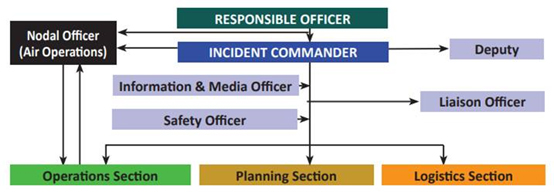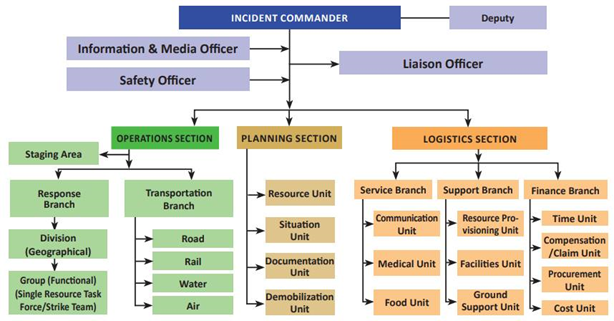Introduction
The National Disaster Management Authority (NDMA) has issued the Guidelines on the Incident Response System (IRS) (8.96 MB)  under Section 6 of the DM Act, 2005 for effective, efficient and comprehensive management of disasters in India. The vision is to minimize loss of life and property by strengthening and standardising the disaster response mechanism in the country.
under Section 6 of the DM Act, 2005 for effective, efficient and comprehensive management of disasters in India. The vision is to minimize loss of life and property by strengthening and standardising the disaster response mechanism in the country.
Though India has been successfully managing disasters in the past, there are still a number of shortcomings which need to be addressed. The response today has to be far more comprehensive, effective, swift and well planned based on a well conceived response mechanism.
The Incident Response System (IRS) is an effective mechanism for reducing ad-hoc measures in response. It envisages a composite team with various Sections to attend to all the possible response requirements. The IRS designates officers to perform various duties and get them trained in their respective roles. It also emphasises the need for proper documentation of various activities for better planning, accountability and analysis. This will greatly help in reducing chaos and confusion during the response phase. Everyone will know what needs to be done, who will do it and who is in command.
IRS Organisation
The broad organization of IRS is as under:

Responsible Officers (ROs) have been designated at the State and District level as overall in charge of the incident response management. The Responsible Officer may delegate responsibilities to the Incident Commander (IC), who in turn will manage the incident through Incident Response Teams (IRTs).
Incident Response Teams
The IRT is an entity comprising of all positions of IRS organisation headed by the Incident Commander as shown in the figure below. The Operations Section helps to prepare and execute different tactical operations required in response to the disaster. The Planning Section helps in obtaining information and preparing plans as required. The Logistics Section assesses the availability and requirement of resources and takes action for obtaining them. IRTs will function at State, District, Sub-Division and the Tehsil / Block levels. The IRTs will be pre-designated at these levels and on receipt of Early Warning, the corresponding Responsible Officer will activate them. In case a disaster occurs without any warning, the local IRT will respond and contact the Responsible Officer for further support, if required.

Organisational Flexibility
The IRS organisation is a need based, flexible organisation. All the components need not be activated simultaneously. Only those Sections, Branches and Units need to be activated that would be required for the given disaster. Each activated Section, Branch or Unit must have a person in charge to perform its role. In some cases, because of lack of personnel, a single supervisor may be made in-charge of more than one Group, Unit or Section. The organisational elements that are no longer required should be deactivated to reduce the size of the organisation and to ensure appropriate use of resources.
IRS Training
It is intended that the IRS be the preferred Disaster Response mechanism in India and the NDMA assists the States and Union Territories (UTs) in conduct of IRS training for their officers. An annual training calendar in prepared at NDMA based on the requests received from the States/ UTs.
IRS Notification
Some states and UTs have already notified the IRS and taken steps to form IRTs.
Reference








